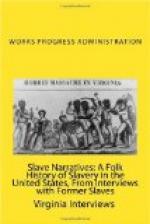I’se saw a red cloud in de west in 1860. I knew war was brewing. Marse Frank went to war. My uncle was his man and went to war with him—Uncle brought him back after the battle at Gettsburg—wounded. He died later. We all loved him. My mistress and her boys ran de plantation.
The blue-coats came to our place in ‘62 and 63. They took everythin’ that was not red-hot or nailed down. The war made no changes—we did the same work and had plenty to eat. The war was now over. We didn’t know we wuz free until a year later. I’se stayed on with Marse Frank’s boys for twenty years. I’se did the same work fo $35 to $40 a year with rations thrown in.
I lived so long because I tells no lies, I never spent more than fifty cents for a doctor in my life. I believe in whiskey and that kept me going. And let me tell you—I’se always going to be a nigger till I die.
[HW: Dist. 5 Ex. Slave #13]
An interview on slavery obtained
from
Mrs. Sarah Byrd—ex-slave
Mrs. Sarah Byrd claims to be 95 years of age but the first impression one receives when looking at her is that of an old lady who is very active and possessing a sweet clear voice. When she speaks you can easily understand every word and besides this, each thought is well expressed. Often during the interview she would suddenly break out in a merry laugh as if her own thoughts amused her.
Mrs. Sarah Byrd was born in Orange County Virginia the youngest of three children. During the early part of her childhood her family lived in Virginia her mother Judy Newman and father Sam Goodan each belonging to a different master. Later on the family became separated the father was sold to a family in East Tennessee and the mother and children were bought by Doctor Byrd in Augusta, Georgia. Here Mrs. Byrd remarked “Chile in them days so many families were broke up and some went one way and der others went t’other way; and you nebber seed them no more. Virginia wuz a reg’lar slave market.”
Dr. Byrd owned a large plantation and raised such products as peas potatoes, cotton corn (etc). There were a large number of slaves. Mrs. Byrd was unable to give the exact number but remarked. “Oh Lordy Chile I nebber could tell just how many slaves that man had t’wuz too many uv em.”
The size of the plantation required that the slaves be classified according to the kind of work each was supposed to do. There were the “cotton pickers”, the “plow hands,” the “hoe hands,” the “rail splitters,” etc. “My very fust job,” remarked Mrs. Byrd, “wuz that uv cotton picking.” Mrs Byrd’s mother was a full [TR: field?] hand.
Houses on the Byrd Plantation were made of logs and the cracks were daubed with mud. The chimnies were made of mud and supported by sticks.




